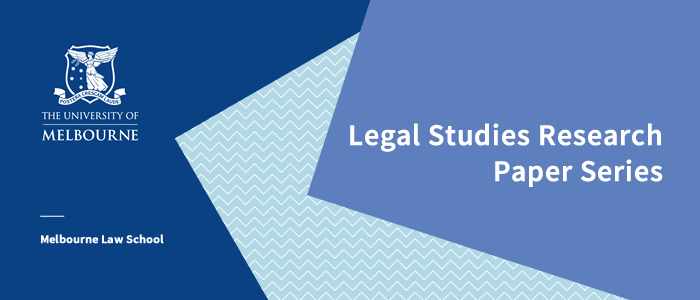Volume 22, No. 7
Wednesday, 19 August 2020

Melbourne Law School published Volume 22 Number 7 of the University of Melbourne Law School Legal Studies Research Paper Series on SSRN.
This issue includes the following articles:
Rosemary Langford
Conflicts and Coherence in the Charities Sphere: Would a Conflict By Any Other Name Proscribe the Same? (899)
Proscriptions on conflicts of interest have long been a core component of governance regimes. In the charities sphere such proscriptions arise from a number of sources, including general law, statute and governance standards articulated by the regulator. Unfortunately the wording of relevant conflicts duties varies extensively, giving rise to acute incoherence and uncertainty. This article undertakes detailed critical analysis of the myriad of conflicts duties in order to provide certainty and comprehensive guidance. This resolution is relevant beyond the charitable sphere given the multitude of ways in which conflicts proscriptions are expressed in other governance contexts.
Laura Schuijers and Margaret Young
Climate Change Litigation in Australia: Law and Practice in the Sunburnt Country (900)
What is the role of litigation in the Australian response to climate change? Catastrophic bushfires and massive coral bleaching of Australia’s iconic Great Barrier Reef have gained worldwide infamy. Litigants have drawn on these and other climate-related events in domestic court proceedings that challenge Australia’s legislative and executive inertia. This chapter examines the potential and limitations of climate-related litigation in Australia. It analyses cases, doctrine and associated legislation at the federal and state level. The chapter investigates suits for failure to mitigate climate change, including challenges to the approval of coal mines that contribute to global greenhouse gas emissions. It compares the relative success of claims relating to adaptation. The growing transnational influence of climate-related proceedings against private enterprises is also discussed, alongside the pending class action against the Australian government for failing to disclose climate risks when issuing sovereign bonds. The chapter demonstrates that judicial decisions, though constrained, provide impetus to improve Australia’s response to climate change. Litigation can help to align Australia’s domestic actions with the international goals of the Paris Agreement.
Julian Murphy
Police Doorknocking in Comparative and Constitutional Perspective: Roy v O’Neill (901)
Roy v O’Neill, currently before the High Court of Australia, raises the question of whether a police officer can knock on a person’s front door to investigate them for potential criminal offending, in circumstances where the police officer has no explicit common law or statutory power to do so. In order to resolve that question, the High Court will need to develop, or at least refine, the common law relating to trespass and implied licences. This column explores two issues relevant to the development of the common law in this area, namely: the approach taken to implied licences in other common law jurisdictions; and the influence, if any, that divergent state and territory legislative positions in this area should have on the development of the single common law of Australia.
Dinesha Samararatne
From South Africa to Sri Lanka: Prospects of Travel for 'Transformative Constitutionalism' (902)
What lessons can we learn from the way in which the South African experience of transformative constitutionalism was invoked in Sri Lanka’s recent constitutional reform experience? What conditions allow experiences of transformative constitutionalism to travel? In this article, I respond to these two questions, using Frankenberg’s idea of a ‘layered approach’ in comparative constitutional law. My analysis affirms that in the comparative enterprise, a thick explanation that allows each experience to ‘speak for itself’ heightens the value of a comparative example. In the case of South Africa, I demonstrate that transformative constitutionalism is in fact a specific genre of constitutionalism. It demands attention not only to substantive constitutional guarantees and institutional design, but also to the process of constitutional reform. Moreover, effective measures for transitional justice are an essential component of transformative constitutionalism. A closer reading of South African experience that paid attention to these factors would have led to better use of this experience in Sri Lanka’s post-war constitutional governance.
Daniel Halliday and Miranda Stewart
On 'Dynastic' Inequality (903)
This chapter investigates whether the replication of inequality is, other things being equal, morally objectionable in ways not applicable to inequality that remains confined to a single generation or ‘birth cohort’. The focus is both theoretical and practical. The chapter considers the philosophical foundations that might lie behind an objection to dynastic inequality, negotiating the diversity of egalitarian views supporting this position, and the complexity around the causal mechanisms at work in cases where inequality has a dynastic tendency. It then discusses the policy reforms that might target inequalities that replicate old distributive trends while leaving newly produced trends more intact, with a focus on tax policy. Current tax rules in most developed economies do not make a distinction between new and old influences on the material distribution. Accordingly, it is likely that the tax reforms implied could be quite extensive.
Ian Ramsay and Stacey Steele
The ‘Safe Harbour’ Reform of Directors’ Insolvent Trading Liability in Australia: Insolvency Professionals’ Views (904)
Directors of Australian companies are subject to a duty to prevent their company trading whilst it is insolvent. The duty is controversial. Over a period of at least ten years, a series of reforms have been proposed, leading up to the introduction, in 2017, of a safe harbour for directors where directors undertake a restructure of the company outside of external administration. There are important questions relating to the safe harbour reform. To assist in answering these questions, the authors undertook a survey of insolvency professionals. The authors had three main goals in undertaking the survey – to obtain insight into the experience of practitioners with the safe harbour reform, to obtain the views of these practitioners on whether the reform has achieved its objectives, and to obtain their views on whether any changes should be made to the safe harbour provisions in light of the independent review of the reform that the Government is required to commission.